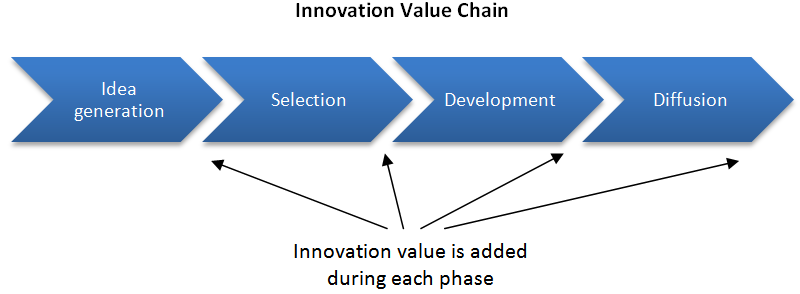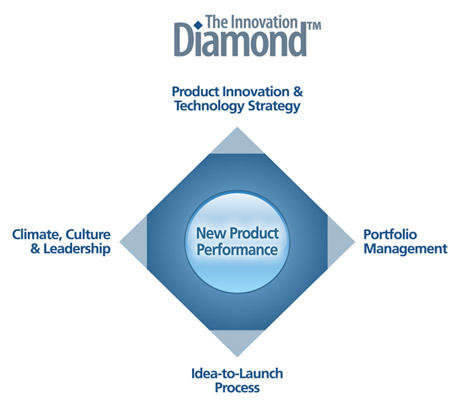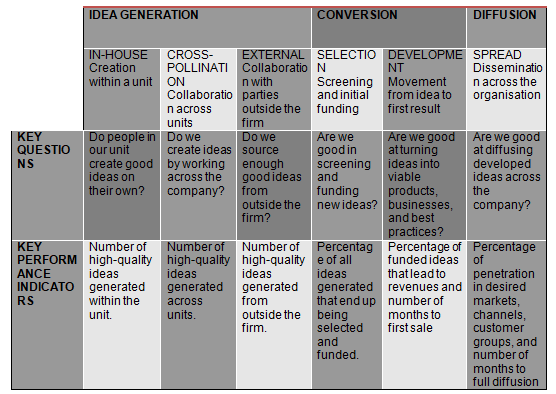Executive Summary
Innovation constitutes an important tool for enhancing competitive advantage for an organisation. Thus, when organisations assess innovation, they acquire the opportunity to make corrective measures to any growth strategies that hinder them from flourishing. This paper proposes diamond model, innovation chain model, innovation funnel model, and corporate ethics as potential plans for analysing novelty at Google China.
The analyses and discussions of these models are based on information that is derived from secondary resources. It is assumed that there are no new versions for these models. Therefore, the secondary information introduces challenges of invalidity and unreliability. The paper has the limitation of generalising its recommendations in different nations where Google has established operation. The focus is on Google China.
Introduction
Over the last 50 years, novelty has been considered an important driving force for economic and organisational growth. Technology and innovation are two hybrid components, which while embraced by manufacturing firms can help drive their productivity. In a business environment that is characterised by intense competition, originality is increasingly being considered a core competency that organisations must develop.
Companies that consistently innovate do not rely on chance. They address innovation in a systematic way. Fundamentally, novelty means the introduction of something that is new in a particular environment. In the business setting, modernism takes place when “new products or services are introduced and successfully commercialised” (Tidd & Bessant 2009, p.7).
However, even in the service sector, empirical research shows that originality has the ability to make organisations develop better quality and low-priced services (Dorner, Gassmann & Gebauer, 2011). Considering the merits of pioneering, its assessment becomes important to help an organisation determine its degree of innovativeness in relation to other organisations.
Purpose
The purpose of this paper is to assess novelty at Goggle China. The assessment is based on conceptual frameworks for assessing modernism in organisations that are drawn from a wide range of literature on novelty. Recommendations are offered on how Goggle China can assess its modernisation better to yield higher competitive advantage.
Background
Assessing modernisation enables organisations understand their status in innovation practices and clarify various needs on which it should focus to ensure better success. It also facilitates customisation of innovation programmes to address weaknesses in novelty practices. The goal of modernisation is to increase competitive advantage for any organisation.
Kanter (2006, p.75) contends with this assertion by adding that high profit margin expectations lure managers and leaders within an organisation to adopt blockbuster modernism thereby expending huge resources.
However, success of newly innovated services and products is unpredictable, and in some situations rare, in the marketplace. This situation suggests that the most appropriate novelty assessment model for Google China should address the underlying weaknesses in originality of products that suit the Chinese marketplace.
Scope
In the manufacturing context, modernisation involves the introduction of new manufacturing processes and practices, new technologies, and new materials among other things, which help lower the costs of production or increase the pace of production and quality of the manufactured products.
However, since novelty is evident in many companies, the scope of this paper is limited to Google China with reference to the aforementioned models.
Methodology
Research can be designed to deploy primary or secondary resources. The current research draws from a wide range of secondary data to propose a model for assessing Google China’s modernism. The search is conducted through online credible libraries to identify articles that discuss models for novelty assessment within organisations.
Using these models, assessment of the company’s modernism is conducted based on specific requirements for operation in the Chinese market. This situation makes it possible to draw points of consistency and inconsistency of the company approaches in novelty with the models.
Assumptions
In the analysis, it is assumed that the approaches followed by Google China in the development of its modernisation reflect the policies of Google Company, since it is one of its constituent companies. It is also assumed that some other recent models (not yet published so that their access is possible) do not outdate the discussed models.
Limitations
Researching on practices that are deployed by organisations to enhance competitive advantage such as novelty presents some limitations. In the case of global organisations, operations in different nations subject them to different policies and regulations.
Thus, the modernisation approaches deployed by Google in China may differ from innovation practices that are deployed elsewhere. This case makes the research possess limitation in the generalisation of the recommendations offered across all nations where Google has established its presence.
Frameworks
Existing research on modernism documents different models for assessing innovation in ICT-based organisations such as Google China, for instance IVC (innovation value chain), diamond model, and innovation funnel.
In addition, Martin (2010) proposes that assessment of innovation in an organisation can also be done in the context of compliance with various standard components of any groundbreaking activity that has high probabilities of success. This case presents a corporate ethical model for assessing novelty in an organisation.
Innovation Value Chain Model

Source: (Hansen & Birkinshaw, 2007)
Proposed by Hansen and Birkinshaw (2007), the model presents modernism as comprising four sequential stages, namely generation of thought, selection, translation, and the diffusion. The framework avails an end-to-end means of evaluating commercial gains for the firm by accessing and developing knowledge, creating originality, and commercialising the developed ideas to enhance its success.
It ensures an in-depth analysis of an organisation’s effectiveness through KPI parameters for assessing novelty as shown in appendix 1. The model may find applicability at Google China since it can be adapted to different levels within the organisation.
Application to the Organisation
The applicability of the value chain model to different sectors within an organisation makes it possible to assess the distribution of various innovative practices across many organs while at the same time comparing modernism at different organs that make an organisation.
This goal may be achieved more effectively by incorporating changes to the model proposed by Roper (2008) so that it provides room for practical interpretation and modelling of three major activities that are incorporated in the modernisation process, namely accessing knowledge, building originality, and commercialising modernism.
Collaboration in the process for knowledge generation and development of novelty may involve an organisation’s internal research and design, substitution, and/or complementation with external knowledge sources (Roper, 2008). The efforts made by Google China to gain access o knowledge can reveal its engagement in innovation activities.
Building originality entails transforming knowledge to ensure codification of modernism in the process and the development of new products or organisational forms. Modernisation is usually generated through collective action of work teams (Von Stamm, 2009, p.14).
Thus, assessing the extent of incorporation of multi-skilled workforce in areas of strategic focus may help reveal the levels of organisational commitment to modernisation. In the context of Google China, building originality may reflect intensities and rates of adoption of deferent types of innovation, both open and hidden forms of modernisation such as marketing activities.
Assessing novelty also requires evaluation of the extent of exploitation of modernism in enhancing sales gains and/or productivity. The model can help in assessing innovation at Google China by revealing its spending in IP protection and in building reputation to improve sales.
Diamond Model
As shown below, the diamond model has five main aspects of novelty assessment, namely product modernisation and technology strategy, idea-to-launch process management, portfolio management, climate, culture, and leadership, and new product performance.

Source: (Rugman & D’Cruz, 1993)
Application in the Organisation
Under this assessment criterion for novelty, Google China can consider three main issues, namely the existence of a strategic plan to foster originality, alignment of the plan with corporate strategy, and the presence of established mechanisms for ensuring effective implementation of corporate strategies (Tidd & Bessant, 2009).
Innovative services and products must serve the needs of customers. Thus, while assessing modernism in an organisation, it is important to consider the degree of flexibility and robustness in the processes that Google applies in developing new products and services. This degree may be assessed from the context of the ability of products and services to meet the needs of the customers (Tidd & Bessant, 2009). Thus, the degree of Google China to manage internal processes may reveal its originality.
Modernism thrives in an environment that fosters a free flow of ideas (Von Stamm, 2009). Evaluating whether management of Google China permits employees to communicate their ideas can help in assessing its innovativeness. In this extent, evaluation of the capacity of the organisational structure of the company to encourage or discourage modernism becomes crucial.
Innovative ideas emanate not only from an organisation’s internal stakeholder, but also from external ones (Von Stamm, 2009). Thus, the capacity of Google China to establish healthy and long-lasting relationships with suppliers, firms, academic partners, specialists, competitors, and even customers present higher or lower opportunities for nurturing innovative culture.
Learning determines the ability of organisations to instil strong and effective training and development programmes to ensure growth in knowledge and expertise of its employees as a strategy of creating an environment for modernisation.
Through evaluating Google China’s learning programmes, its capacity to generate and garner information through linkages measures the degree of its novelty. Learning provides the pillar on which assessment of novelty in an organisation is conducted based on its capacity to share information on past failures and success stories (Tidd & Bessant, 2009).
Innovation Funnel Model
Funnel model has nine aspects or steps that can be used in assessing modernisation in an organisation. These are “strategic thinking, portfolio and metrics, research, ideation, insight, targeting, originality development, market development, and selling” (Tidd & Bessant, 2009, p.16).
In applying this model in assessing innovation at Google China, these steps can be divided into three separate major stages in the next sub-section on application of the model at Google China.
Application in the Organisation
The first step in weighing up novelty using innovation funnel model encompasses portfolio, metrics, and the strategy. This step defines modernisation inputs such as scope, structures, and the context of the change that is necessary for its creation (Tidd & Bessant, 2009).
Step 2 involves the novelty processes such as research, insights, development of ideas, targeting, originality development, and the process of developing markets. Step 3 considers outputs. This step implies that any innovative activity must generate economic gain for Google China. These process interactions among various players within the organisation are important.
Corporate Ethics Model
Corporate ethics model considers the capacity of an organisation to follow various novelty rules.
Martin (2010) defines these rules as interventions made by an organisation to ensure a positive reception of modernisation, impacts of novelty on people, and impacts of people on transformation, the disruption of status quo, the shared responsibility of reconstruction, the capacity to enhance continued modification, and features of the innovated products and services.
Apart from revealing the innovativeness of an organisation, this model also provides a means of analysing the effectiveness of innovation of Google China.
Application at the Organisation
At Google China, novelty brings about change. Thus, corporate ethics model constitutes one of the important mechanisms of assessing it. The model highlights the necessity for integrating various environmental dynamics within organisations to yield success for an organisation in the long term.
Critical Analysis
Gaps Identified
Models for assessing novelty within an organisation seek to establish the necessary areas of improvement or gaps upon the development of better processes, restructuring an organisation’s development strategic plans, incorporation of training and development, and establishing relationships among other concerns.
Through gap identification, it becomes possible to recognise mistakes that may hinder novelty such as “impulse to struggle innovation with tight controls such as the same planning, budgeting, and reviews applied to the existing business” (Kanter, 2006, p.76).
Google China has gaps in modernisation in terms of development of products that have the capacity of penetrating into the burgeoning cell phones market in an effort to foster higher growth in sales, as an essential output for novelty as suggested by diamond model. Google China also experiences competition in the advertising industry from other organisations such as Facebook and other social networks.
Strengths
Irrespective of the model that is deployed to assess innovation within an organisation, the focus should be on utilising opportunities and strengths to overcome weakness and threats. Google China has established a central position on the search industry. It holds the highest share in the market of more than 60%. China is also experiencing an immense growth in android applications.
Through Smartphone, android applications make it possible to access many of the Google products. The company has low acquisition costs in comparison with revenues. The advancement of Google chrome encompasses one of the major achievements of the company with the capacity to enhance its dominance in the Chinese market in comparison with its competitors such as Yahoo.
Although Google China has the pressure to develop more innovation to participate competitively in the changing technological world, based on corporate ethical model and funnel model, it evidences the presence of innovation. From the context of funnel model, an organisation must utilise its resources to enhance the development of new products and services (Tidd & Bessant, 2009).
Google China values its people as an important source of competitive advantage through improvement of new products and services that meet the needs of the Chinese market.
This claim implies that the process of modernisation incorporates the needs of the target market to ensure a positive reception of the products. In this context, Martin (2010) insists that unlike Yahoo, Google Company took much time to evaluate strategies for designing its search technology to ensure it complies with governmental regulations.
Weaknesses
Assessing novelty in an organisation from the context of innovation value chain model requires the investigation of an organisation’s capacity to access knowledge, build originality, and commercialise it (Hansen & Birkinshaw, 2007). Accessing knowledge requires interaction with internal and external stakeholders to identify possible areas of transformation, which can help build the success of an organisation.
This concern reflects the need to develop products such that they influence communities in a positive way (Martin, 2010, p.24). In this extent, Google China’s innovativeness becomes evident if it has derived strategies to minimise the impacts of weaknesses of its products to receive a negative reception by the communities that consume them.
The major weakness of Google China is the lack of incredible appearance on social media, especially upon considering that the trend on search advertising is on relying on social media to communicate to communities that consume such products and services.
Yahoo Company released a blogger’s name in an effort to comply with Chinese authority requirements on censorship. This provided evidence that was required in sending the accused person to prison.
Consequently, its penetration in the Chinese market became problematic. Using the innovation strategy for putting in place a mechanism of enhancing positive reception by the community, Google China decided to maintain personalised information, especially with relation to e-mails and weblogs within a database situated outside China.
Hence, amid its weakness in the Chinese market, this innovative idea has translated into the immense dominance of Google China in the Chinese market.
Recommendations
Innovation is the only tool for ensuring that an organisation acquires a competitive advantage. For the Google Company, modernisation is recommended as a critical element in the endeavour to increase the ability to address the various needs of more diverse Google customer base. One of the principal mechanisms of nurturing novelty should involve integration of people in the innovative design processes.
For example, Google can gain from the various viewpoints of its diverse workforce in the effect that such a workforce provides increased problem-solving capacities, which lead to advancement of new products and services. This recommendation is critical for the success and performance of the organisation in the future unknown dynamic business environment.
The fact that the company embraces principles of corporate ethics, apart from their application with success in the Chinese market, it should also consider applying them in the development and customisation of products to suit other markets.
Such strategies can ensure that the organisation is always a preferred choice among its target markets. In this context, a hybrid of the corporate ethics and diamond model for assessing modernism is recommended.
Conclusion
Innovation and creativity are crucial in gaining a competitive advantage in the modern dynamic market that is characterised by influx of many products and services. Google China accepts that improvement cannot be negated while producing products, which always hit in the marketplace.
Hence, assessing this novelty is of paramount importance. An organisation can only measure its extent of modernism through the deployment of various models of gauging innovation. Four of these models were discussed in the paper together with their applicability at Google China.
Reference List
Dorner, N., Gassmann, O., & Gebauer, H. (2011). Service innovation: why is it so difficult to accomplish? Journal of Business Strategy, 32(3), 37-46.
Hansen, M., & Birkinshaw, J. (2007). The Innovation, Value Chain. Harvard Business Review, 85(6), 87-98.
Kanter, R. (2006). Innovation: The Classic Traps. Harvard Business Review, 84(11), 72-83.
Martin, K. (2010). Innovation, Ethics and Business. Sidney: Institute for Corporate Ethics.
Roper, N. (2008). Modelling Innovation Value Chain. Research Policy, 3(1), 45-53.
Rugman, M., & D’Cruz, R. (1993). The double diamond model of international competitiveness: Canada’s experience. Management International Review, 33(2), 17–39.
Tidd, J., & Bessant, J. (2009). ‘Managing Innovation: Integrating Technological, Market and Organisational Change. The International Journal of Educational Management, 21(1), 6-25.
Von Stamm, B. (2009). Leadership for Innovation: what can you do to create a culture conducive to innovation? Strategic Direction, 25(6), 13-15.
Appendix
